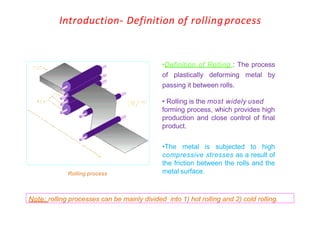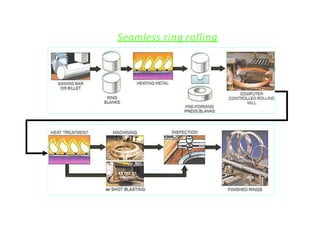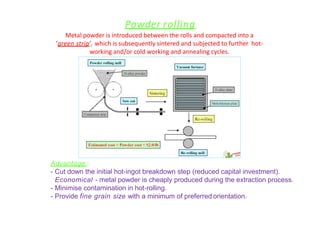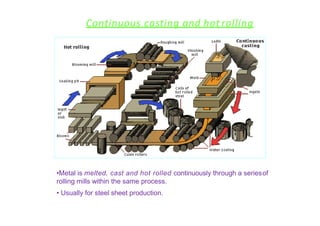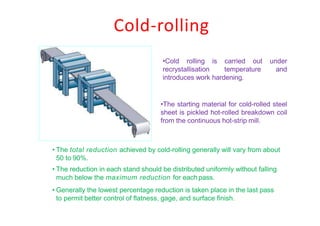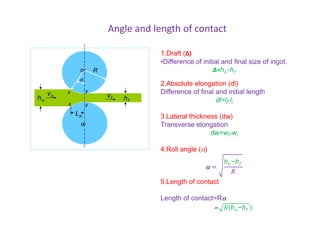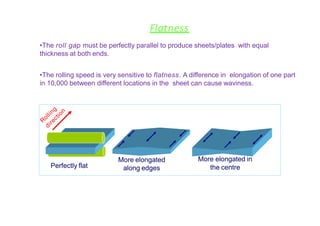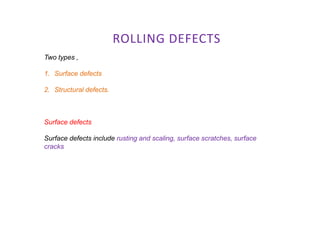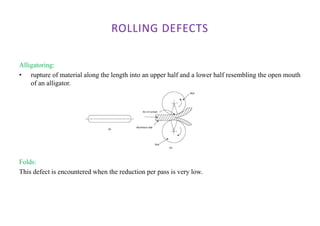Rolling slides
- 2. Introduction- Definition of rollingprocess •Definition of Rolling : The process of plastically deforming metal by passing it between rolls. • Rolling is the most widely used forming process, which provides high production and close control of final product. •The metal is subjected to high compressive stresses as a result of the friction between the rolls and the metal surface.Rolling process Note: rolling processes can be mainly divided into 1) hot rolling and 2) cold rolling.
- 3. Terminology Bloom is the product of first breakdown of ingot (cross sectional area > 230 cm2). • Billet is the product obtained from a further reduction by hot rolling (cross sectional area > 40x40 mm2). • Slab Semi- finished products • Plate is the product with a thickness > 6 mm. • Sheet is the product with a thickness < 6 mm and width > 600 mm. • Strip is the product with a thickness < 6 mm and width < 600 mm. Mill products Further rolling steps Bloom Billet Slap is the hot rolled ingot (cross sectional area > 100 cm2 and with a width 2 x thickness). Plate Sheet Strip
- 4. Introduction- Hot and cold rollingprocesses •The initial breakdown of ingots into blooms and billets is generally done by hot- rolling. This is followed by further hot- rolling into plate, sheet, rod, bar, pipe, rail. Hot rolling Cold rolling •The cold-rolling of metals has played a major role in industry by providing sheet, strip, foil with good surface finishes and increased mechanical strength with close control of product dimensions.
- 5. Mill rolls Mill rolls Rolls Tapany Udomphol
- 6. Typical arrangement of rollers for rolling mills Two-high mill, pullover The stock is returned to the entrance for further reduction. Two-high mill, reversing The work can be passed back and forth through the rolls by reversing their direction of rotation. Three-high mill Consist of upper and lower driven rolls and a middle roll, which rotates by friction. Four-high mill Small-diameter rolls (less strength & rigidity) are supported by larger-diameter backup rolls Cluster mill or Sendzimir mill Each of the work rolls is supported by two backing rolls.
- 7. •Use a series of rolling mill and each set is called a stand. •The strip will be moving at different velocities at each stage in the mill. •The speed of each set of rolls is synchronised so that the input speed of each stand is equal to the output speed of preceding stand. •The uncoiler and windup reel not only feed the stock into the rolls and coiling up the final product but also provide back tension and front tension to thestrip. b f Typical arrangement of rollers for rolling mills Continuous rolling or tandem mil.
- 8. Planetary mill • Consist of a pair of heavy backing rolls surrounded by a large number of planetary rolls. •Each planetary roll gives an almost constant reduction to the slab as it sweeps out a circular path between the backing rolls and the slab. •As each pair of planetary rolls ceases to have contact with the work piece, another pair of rolls makes contact and repeat that reduction. •The overall reduction is the summation of a series of small reductions by each pair of rolls. Therefore, the planetary mill can hot reduces a slab directly to strip in one pass through the mill. •The operation requires feed rolls to introduce the slab into the mill, and a pair of planishing rolls on the exit to improve the surface finish. Typical arrangement of rollers for rolling mills
- 9. Rolling mills •Requires very rigid construction, large motors to supply enough power (MN). Successive stands of a large continuous mill Modern rolling mill Huge capital investment+ • skills • engineering design • construction A rolling mill basically consists of • rolls • bearings • a housing for containing these parts • a drive (motor) for applying power to the rolls and controlling the speed Rolling mill is a machine or a factory for shaping metal by passing it through rollers Planetary mill
- 10. Different types of rollingprocesses There are different types of rolling processes as listed below; • Continuous rolling • Transverse rolling • Shaped rolling or sectionrolling • Ring rolling • Powder rolling • Continuous casting and hot rolling • Thread rolling
- 11. Conventional hot or cold-rolling The objective is to decrease the thickness of the metal with an increase in length and with little increase in width. •The material in the centre of the sheet is constrained in the z direction (across the width of the sheet) and the constraints of undeformed shoulders of material on each sideof the rolls prevent extension of the sheet in the width direction. •This condition is known as plane strain. The material therefore gets longer and not wider. •Otherwise we would need the width of a football pitch to roll down a steel ingot to make tin plate!
- 12. Transverse rolling • Using circular wedge rolls. • Heated bar is cropped to length and fed in transversely between rolls. • Rolls are revolved in one direction.
- 13. Shaped rolling or sectionrolling •A special type of cold rolling in which flat slap is progressively bent into complex shapes by passingit through a series of driven rolls. •No appreciable change in the thickness of the metal during this process. •Suitable for producing moulded sections such as irregular shaped channels and trim.
- 14. Shaped rolling or sectionrolling A variety of sections can be produced by roll forming process using a series of forming rollers in a continuous method to roll the metal sheet to a specific shape - construction materials, - partition beam - ceiling panel - roofing panels. - steel pipe - automotive parts - household appliances - metal furniture, - door and window frames - other metal products. Applications:
- 15. Seamless rings Ring rolling • Seamless (i.e., without a joint) rings find wide application in industry. • The inner and outer races of ball and roller bearings, steel tyres for railway wheel are some such applications. • These rings are made by a special rolling process called ring rolling.
- 16. Cantilever mill roll Tube mill roll Universal roll Ring rolls •Ring rolls are used for tube rolling, ring rolling. •Ring rolls are made of spheroidized graphite bainitic and pearlitic matrix or alloy cast steel base.
- 18. Powder rolling Metal powder is introduced between the rolls and compacted into a ‘green strip’, which is subsequently sintered and subjected to further hot- working and/or cold working and annealing cycles. Advantage : - Cut down the initial hot-ingot breakdown step (reduced capital investment). - Economical - metal powder is cheaply produced during the extraction process. - Minimise contamination in hot-rolling. - Provide fine grain size with a minimum of preferred orientation.
- 19. Continuous casting and hotrolling •Metal is melted, cast and hot rolled continuously through a seriesof rolling mills within the same process. • Usually for steel sheet production.
- 20. Thread rolling • The resultant thread is very much stronger than a cut thread. It has a greater resistance to mechanical stress and an increase in fatigue strength. Also the surface is burnished and work hardened. •Dies are pressed against the surface of cylindrical blank. As the blank rolls against the in-feeding die faces, the material is displaced to form the roots of the thread, and the displaced material flows radially outward to form the thread's crest. •A blank is fed between two grooved die plates toform the threads. •The thread is formed by the axial flow of material in the work piece. The grain structure of the material is not cut, but is distorted to follow the thread form. •Rolled threads are produced in a single pass at speeds far in excess of those used to cut threads. Cut thread and rolled thread
- 21. Hot-rolling •The first hot-working operation for most steel products is done on the primary roughing mill •These mills are normally two-high reversing mills with 0.6-1.4 m diameter rolls (designated by size). •The objective is to breakdown the cast ingot into blooms or slabs for subsequent finishing into bars, plate or sheet. Plate rolling
- 22. Cold-rolling •The starting material for cold-rolled steel sheet is pickled hot-rolled breakdown coil from the continuous hot-strip mill. • The total reduction achieved by cold-rolling generally will vary from about 50 to 90%. • The reduction in each stand should be distributed uniformly without falling much below the maximum reduction for each pass. • Generally the lowest percentage reduction is taken place in the last pass to permit better control of flatness, gage, and surface finish. •Cold rolling is carried out under recrystallisation temperature and introduces work hardening.
- 23. Cold-rolling •Cold rolling provide products with superior surface finish (due tolow temperature no oxide scales) •Better dimensional tolerances compared with hot-rolled products due to less thermal expansion. •Cold-rolled nonferrous sheet may be produced from hot-rolled strip, or in the case of certain copper alloys Cold rolled metals •Quarter hard : Higher amount of deformation. Can be bent normal to rolling direction without fracturing • Half hard : Can be bent up to 90o. •Full hard : Metal is compressed by 50% with no cracking. Can be bent up to 45o.
- 24. video
- 25. Fundamental concept of metalrolling 1) The arc of contact between the rolls andthe metal is a part of a circle. 2) The coefficient of friction, , is constant in theory, but in reality varies along the arc of contact. 3) The metal is considered to deform plastically during rolling. 4) The volume of metal is constant beforeand after rolling. In practical the volume might decrease a little bit due to close-up of pores. 5) The velocity of the rolls is assumed to be constant. 6) The metal only extends in the rolling direction and no extension in the width of the material. Assumptions hfho vo vf Lp o R o x x y y
- 26. Forces and geometrical relationships in rolling hfho vo vf Lp R o o x x y y •A metal sheet with a thickness ho enters the rolls at the entrance plane xx with a velocity vo. •It passes through the roll gap and leaves the exit plane yy with a reduced thickness hf and at a velocity vf. •Given that there is no increase in width, the vertical compression of the metal is translated into an elongation in the rolling direction. •Since there is no change in metal volume at a given point per unit time throughout the process, thereforebhovo bhv bhf vf …Eq.1 Where b is the width of the sheet v is the velocity at any thickness h intermediate between ho and hf.
- 27. hfho vo x’ x y y’ From Eq.1 bhovo bhf vf Given that bo = bf o Lf f t Lo th h Then we have vo ho v f hf vo vf hf ho …Eq.2 vf vo < vf When ho > hf , we then have vo < vf
- 28. Roll bite condition For the workpiece to enter the throat of the roll, the component of the friction force must be equal to or greater than the horizontal component of the normal force. F cos Pr sin Pr cos F sin tan But we know F Pr tan Therefore F Fcos Prsine Pr F Pr is a tangential friction force is radial force …Eq.5 • If tan > , the workpiece cannot be drawn. • If = 0, rolling cannot occur. The angle of bite or the angle of contact
- 29. From triangle ABC, we have L2 L2 R2 p p p R2 (R2 2Ra a2 ) 2Ra a2 L2 (R a)2 As a is much smaller than R, we can then ignore a2. Lp 2Ra Rh Where h = ho – hf = 2a …Eq.6 a h B Lp R R-a C Dvo ho The critical variables are Lp and h A A large diameter roll will permit a thicker slab to enter the rolls than will a small-diameter roll. h R Rh R h / 2 Lp R h / 2 tan …Eq.7max 2 Rh The maximum reduction
- 30. Angle and length of contact hfho vo vf Lp R o o x x y y 1.Draft (Δ) •Difference of initial and final size of ingot. Δ=ho-hf 2.Absolute elongation (dl) Difference of final and initial length dl=lf-li 3.Lateral thickness (dw) Transverse elongation dw=wf-wi 4.Roll angle () = ho−hf 𝑅 5.Length of contact Length of contact=R 𝑅(ho−hf )
- 31. Flatness •The roll gap must be perfectly parallel to produce sheets/plates with equal thickness at both ends. •The rolling speed is very sensitive to flatness. A difference in elongation of one part in 10,000 between different locations in the sheet can cause waviness. Perfectly flat More elongated along edges More elongated in the centre
- 32. •Camber and crown can be used to correct the roll deflection (at only one value of the roll force). Or use rolling mill equipped with hydraulic jacks to permit the elastic distortion of the rolls to correct deflection. (a) (b) (a) The use of cambered rolls to compensate for roll bending. (b) Uncambered rolls give variation of thickness. Solutions to flatnessproblems
- 33. Possible effects when rolling with insufficient camber (a ) (b ) (c) (d) (e) •Thicker centre means the edges would be plastically elongated more than the centre, normally called long edges. •This induces the residual stress pattern of compression at the edges and tension along the centreline. •This can cause centreline cracking (c), warping (d) edge wrinkling or wavy edge(e).
- 34. ROLLING DEFECTS Two types , 1. Surface defects 2. Structural defects. Surface defects Surface defects include rusting and scaling, surface scratches, surface cracks
- 35. ROLLING DEFECTS Structural defects. These defects include the following: (i) Wavy edges (ii) Zipper cracks (iii) Edge cracks (iv) Centre split (v) Alligatoring (vi) Folds
- 36. ROLLING DEFECTS Wavy edges and zipper cracks: • These defects are caused due to bending of rolls under the rolling pressure. • This causes tensile stress in the centre and compressive stress in the edges. The former causes zipper cracks in the centre and the latter causes wavy edges. • Remedy for zipper cracks and wavy edges lies in provide a “camber” to the rolls. They are made slightly convex in the central portion to offset the effect of deflection under rolling loads. Edgecracks and centre split: • These defects are caused due to non homogeneous plastic deformation of metal across the width. • As the work piece passes through the rolls, under the rolling pressure its height decreases while its length increases.
- 37. ROLLING DEFECTS Alligatoring: • rupture of material along the length into an upper half and a lower half resembling the open mouth of an alligator. Folds: This defect is encountered when the reduction per pass is very low.


